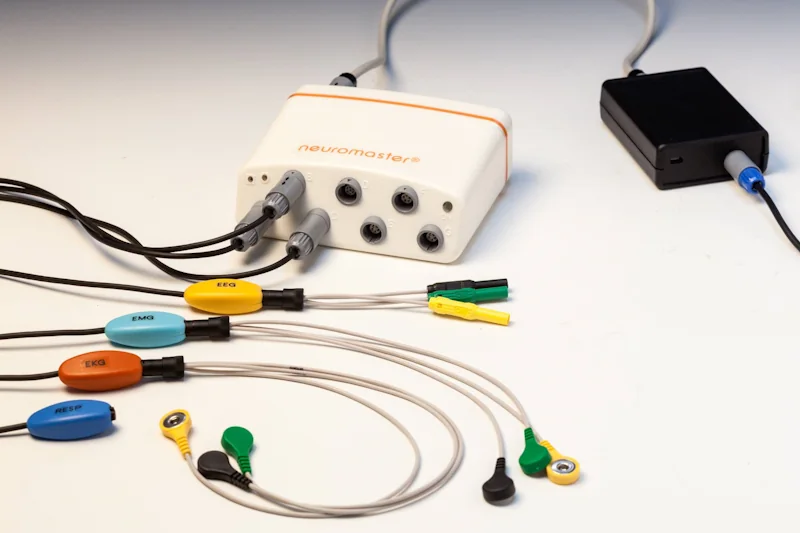BIO- AND NEUROFEEDBACK DEVICE
The Neuromaster System
Professional hardware and software for biofeedback, neurofeedback and psychophysiological research. The modular design of the Neuromaster system allows a high degree of flexibility and individuality for therapists and users.
The Neuromaster is a medical device according MDR Kl. I.
Versatile & flexible
The Neuromaster (Made in Germany) is a medical device and can be used universally for biofeedback, neurofeedback and psychophysiological research. The structure of the system is completely modular, so you can start small and add to your system as required. Whether for training or research, the Neuromaster system offers the right solution for all users!
Bio- and Neurofeedback
You don’t have to choose — both variants in one device!
Easy-to-use Software
Plug and play.
Flexible in every detail
Sitting with mains power, mobile with wireless operation or without PC with local SD card storage.
Service
Training, tutorials, marketing and certified training – all from a single source.
Versatile
Measure muscle tension, respiration, skin conductance, temperature, pulse and much more.
Heart rate variability
Precise measurement and evaluation of HRV
with ECG module
Session libraries
14 session libraries – almost 200 ready-to-use, specific biofeedback and neurofeedback session templates.
Custom templates
Not the right session template? Create your own sessions easily with the drag & drop builder.
HARDWARE
Neuromaster and sensors
The centrepiece of the system is the Neuromaster. It is a multimodal professional biofeedback and neurofeedback device with 3 operating modes (wireless operation, stationary via mains adapter, mobile 24-hour measurement). The device offers biofeedback AND neurofeedback.
The Neuromaster includes the sensors. Six different sensors record up to 28 parameters. The sensors were developed in such a way that measurement artefacts caused by cable movement are almost completely eliminated!

Sensors
Multisensor
The multi-sensor simultaneously records the skin conductance, pulse, pulse rate and temperature on one finger. It is therefore not necessary to wire four fingers, as is the case with other systems! The multisensor and its parameters are widely used for stress tests, relaxation and training.
EMG Sensor
The EMG sensor accurately records muscle tension. The sensor is used to analyse and relax overstretched muscles. The EMG sensor is also used to target and build up muscles. Applications for EMG training include pain management, rehabilitation and occupational therapy.
ECG sensor
The ECG sensor records the heart rate via ECG and is particularly suitable for precisely analysing and training heart rate variability.
Breath sensor
The breath sensor records the breathing curve, breathing frequency and breathing depth without contact using infrared. The non-contact measurement means that it is not necessary to wear an abdominal belt, as is the case with other systems. The aim of breath training is to learn slow and deep abdominal breathing.
Vaso sensor
The VASO sensor records the peripheral blood flow in the temporal artery. The pulse amplitude is calculated from this. This allows the opening and closing of the temporal artery to be recorded and analysed. The sensor is mainly used for vasoconstriction training for migraines.
EEG sensor
The EEG sensor is used for neurofeedback and records the client’s brain activity. The following frequency bands are recorded: Delta, theta, alpha and beta (low-beta, SMR, beta, high-beta).
SOFTWARE
Biolife and session libraries
The Neuromaster system is controlled via our in-house Biolife software. With its intuitive and easy-to-understand structure, this helps you to start working immediately. The software offers a wide range of conveniences (a separate screen for the test person and therapist, a comprehensive HRV module, statistical analyses, etc.).
Our session libraries also support you here. These are comprehensive sets of session templates that can be started for specific indications with just one click.
Available session libraries:

Analysis
The analysis sessions can be used to record the physiological effects of various psychological stressors, the individual’s ability to relax and the individual progress of your clients (pre- and post-comparisons of the stress reaction at the beginning and end of the training). Muscle feedback, breathing feedback and skin conductance feedback are utilised.

Heart rate variability
With the heart rate variability sessions, your clients learn to positively influence their heart rate variability through breathing and pulse feedback in order to promote relaxation. As part of hand warming training, clients can also learn to use temperature feedback to influence the blood circulation in their hands, for example to reduce feelings of coldness or numbness in the hands.

Eating
Using feedback, your clients will improve their self-control and self-efficacy by actively influencing physical reactions in relation to food, the ability to relax in the presence of food, the healthy regulation of food intake, the improvement of interoceptive perception and thus the reduction of binge eating.

Stress prevention
The individual stress reaction of your clients can initially be recorded using the available stress tests. Relaxation training and abdominal breathing training can be used to learn how to influence the physiology in the direction of relaxation. In this way, body awareness can be improved and the ability to consciously induce relaxation – even in mentally stressful situations – can be learnt.

Neurofeedback
Using neurofeedback, EEG frequency bands are fed back with the aim of learning how to influence them. Feedback can be used to learn to consciously control the proportion of such frequency bands in specific sessions. Session types: Stress profiles for adults and children, alpha training, beta training, low-beta training, SMR training, theta training, beta-theta training, alpha-beta training.

Relaxation training
Imaginary journeys (e.g. mountains, oasis, lake), relaxation music, instructions for hand warming, muscle relaxation and deep breathing will lead your clients into worlds beyond everyday life and stress into relaxation.

Sleep training
Breathing training (e.g. deep abdominal breathing) and relaxation training (hand warming and muscle tension feedback) will help your clients with their general relaxation skills, helping them to get into the ideal stage for restorative sleep.

Pain prophylaxis
Using pulse amplitude feedback (vasoconstriction training on the temporal artery) and temperature feedback (hand warming training), clients can learn to counteract migraine attacks or reduce their duration and intensity. In addition, relaxation training (abdominal breathing training with breathing feedback and muscle relaxation with EMG feedback) can be used to specifically visualise and relax muscular tension, such as tension in the head and back area.

Muscle perception
After learning a general ability to relax, discriminative muscle perception is trained using EMG feedback, for example on the masseter, temporalis and frontalis muscles. The level of difficulty of the tension and relaxation exercises (e.g. in progressive muscle relaxation sessions – PMR) increases continuously as the training progresses in order to accompany the client’s individual progress.

Children
All training units (hand warming, muscle relaxation, vegetative relaxation, stress analysis and breathing training) are playfully prepared and incorporated into child-friendly stories or small games (puzzles, scoring points, etc.).

Muscle building
The muscle-building sessions contain targeted sequences of tensing and relaxing the muscles. This allows your clients to strengthen their muscle awareness, build up weakened muscles and monitor their progress directly through EMG feedback. Especially for EMG-supported muscle training in incontinence therapy and rehabilitation (paralyses, plegia, paresis).

Respiratory training
Through abdominal breathing training, breathing frequency and muscle tension feedback, your clients gradually learn the optimum individual breathing rhythm for relaxation. Respiratory feedback on the screen can be used to work specifically on reducing chest breathing and increasing abdominal breathing, making you aware of your own breathing and thus inducing relaxation in a targeted manner.

Confrontational training
By means of relaxation-promoting preparatory training (abdominal breathing, muscle relaxation) and confrontation training with skin conductance feedback, your clients learn to face their anxiety in different areas (heights, medical examinations, confined spaces, car journeys, spiders, snakes).

Addictive substances
Confrontation training in the context of alcohol, nicotine and food alternates with relaxation phases. The aim is to relax the client before and after the confrontation. Preparatory breathing training and muscle relaxation training also help to support the ability to relax.
Ready for more information?
Request free and non-binding informational materials from Biofeedback and Neurofeedback!
You will receive:
- Information brochure about Neuromaster and its benefits
- Fields of Application of Neuromaster
- Personal consultation via phone or Zoom, if desired: please provide your preferred date and time in the form.

